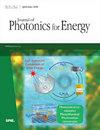Enhanced photocatalytic performance of direct Z-scheme Bi4Ti3O12/SrTiO3 photocatalysts for CO2 reduction to solar fuel
IF 2.1
4区 工程技术
Q4 MATERIALS SCIENCE, MULTIDISCIPLINARY
引用次数: 2
Abstract
Abstract. Solar-driven CO2 reduction to solar fuel is an effective way to deal with the greenhouse effect and energy crisis. A one-step hydrothermal method was used to synthesize Bi4Ti3O12 / SrTiO3 composite photocatalysts. The heterogeneous structure formed by intimate contact was observed between SrTiO3 (STO) nanoparticles and Bi4Ti3O12 (BTO) nanoplates, achieving an enhanced photocatalytic CO2 reduction yield of CO (13.37 μmol / g) that was 5.74-fold that of pure STO (2.33 μmol / g), with a high yield of CH4 (1.55 μmol / g). Characterizations of phase composition, morphology, and optical/electrochemical properties were applied to prove the heterojunction structure and its role in improving the photocatalytic performance. X-ray photoelectron spectroscopy and ultraviolet photoelectron spectroscopy tests demonstrate that electrons transfer from STO to BTO and result in the generation of an internal electron field between the two phases. Consequently, a direct Z-scheme system was formed: photoelectrons in the conduction band of BTO transferred to the valence band of STO to recombine with the holes thus spatially separated the photogenerated electron–hole pairs while enabling the photocatalyst to achieve the maximum reduction and oxidation capability. The catalyst structure system proposed here may bring new ideas for the development of titanate-based photocatalysts with high CO2 reduction activity.直接Z方案Bi4Ti3O12/SrTiO3光催化剂用于CO2还原为太阳能燃料的光催化性能增强
摘要将太阳能驱动的二氧化碳减排为太阳能燃料是应对温室效应和能源危机的有效途径。采用一步水热法合成了Bi4Ti3O12 / SrTiO3复合光催化剂。SrTiO3 (STO)纳米颗粒与Bi4Ti3O12 (BTO)纳米片紧密接触形成了非均相结构,提高了CO的光催化还原率(13.37 μmol / g),是纯STO (2.33 μmol / g)的5.74倍,CH4的光催化还原率(1.55 μmol / g)较高。通过相组成、形貌和光学/电化学性能的表征来证明异质结结构及其在提高光催化性能方面的作用。x射线光电子能谱和紫外光电子能谱测试表明,电子从STO转移到BTO,并导致两相之间产生内部电子场。因此,形成了一个直接的Z-scheme体系:BTO导带中的光电子转移到STO的价带中与空穴重新结合,从而使光生电子-空穴对在空间上分离,同时使光催化剂达到最大的还原和氧化能力。本文提出的催化剂结构体系为开发具有高CO2还原活性的钛酸盐基光催化剂提供了新的思路。
本文章由计算机程序翻译,如有差异,请以英文原文为准。
求助全文
约1分钟内获得全文
求助全文
来源期刊

Journal of Photonics for Energy
MATERIALS SCIENCE, MULTIDISCIPLINARY-OPTICS
CiteScore
3.20
自引率
5.90%
发文量
28
审稿时长
>12 weeks
期刊介绍:
The Journal of Photonics for Energy publishes peer-reviewed papers covering fundamental and applied research areas focused on the applications of photonics for renewable energy harvesting, conversion, storage, distribution, monitoring, consumption, and efficient usage.
 求助内容:
求助内容: 应助结果提醒方式:
应助结果提醒方式:


